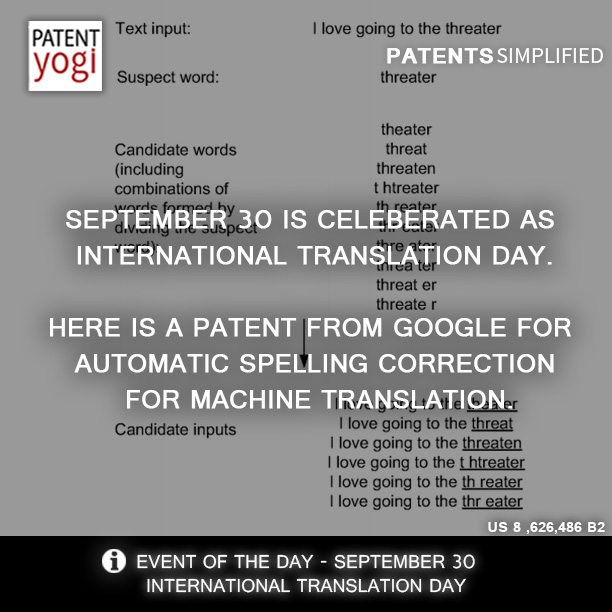International Translation Day is celebrated every year on 30 September on the feast of St. Jerome, the Bible translator who is considered the patron saint of translators.
Here is a patent from Google for automated spelling correction for machine translated text.
Problems before this patent
A drawback of machine translation systems is that such systems may assume that the text has correct spelling. Any incorrectly spelled word in the input text may result in an incorrect, incomplete, or incomprehensible translation. Asking the author of the web page or the user requesting the translation to correct the spelling in the web page would generally be impractical.
Solutions provided by this patent
Automatic spelling correction method receives a text input for translation. One or more suspect words in the text input are identified. For each suspect word, one or more candidate words are identified. A score for the text input and scores for each of one or more candidate inputs are determined, where each candidate input is the text input with one or more of the suspect words each replaced by a respective candidate word. If any, a candidate input whose score is highest among the scores for the candidate inputs and is greater than the text input score by at least a threshold is selected. Otherwise, the text input is selected. A translation of a selected candidate input or the selected text input is provided as the translation of the text input.
Using this method, machine translation of text can be more efficient. Spelling errors or regional spelling variations in text can be accounted for by a translation system when the translation system is attempting to translating the text.
Patent Information
Patent Number: US 8626486 B2
Patent Title: Automatic spelling correction for machine translation
Application number: US 11/850,623
Publication date: 7 Jan 2014
Filing date: 5 Sep 2007
Priority date: 5 Sep 2006
Also published as: US20130144592
Inventors: Franz J. Och, Dmitriy Genzel
Original Assignee: Google Inc.
Abstract: Methods, systems, and apparatus, including computer program products, for correcting spelling in text. A text input is received for translation. One or more suspect words in the text input are identified. For each suspect word, one or more candidate words are identified. A score for the text input and scores for each of one or more candidate inputs are determined, where each candidate input is the text input with one or more of the suspect words each replaced by a respective candidate word. If any, a candidate input whose score is highest among the scores for the candidate inputs and is greater than the text input score by at least a threshold is selected. Otherwise, the text input is selected. A translation of a selected candidate input or the selected text input is provided as the translation of the text input.

